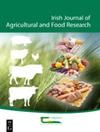奶牛遗传群对生全脂乳密度的影响
IF 1.4
4区 农林科学
Q3 AGRICULTURE, MULTIDISCIPLINARY
引用次数: 2
摘要
牛奶的密度取决于各种因素,包括温度、加工条件和动物品种。本研究评估了不同奶牛遗传群体,泽西岛、荷斯坦优良奶牛(EHF)和全国平均荷斯坦优良牛(NAHF)对牛奶成分和物理化学性质的影响。每2周采集一次约1040份具有代表性的(上午和晚上)牛奶样本(9个月内每月约115份)。用Bentley-Dairyspec仪器测定牛奶成分。数据采用混合线性模型进行分析,该模型包括采样月份、遗传组、月份和遗传组之间的相互作用的固定影响,以及奶牛的随机影响,以解释对同一动物的重复测量。使用三种不同的分析方法测定牛奶密度——便携式和标准台式密度计以及100 cm3校准玻璃比重瓶。用与牛奶成分相同的混合模型分析牛奶密度,但包括作为固定效应的分析方法。泽西奶牛的脂肪含量平均值最高(5.69±0.13%),其次是EHF(4.81±0.16%)和NAHF(4.30±0.15%)。与EHF(1.0304±0.00026 g/cm3)和NAHF1.0303±0.00024 g/cm3)遗传组相比,泽西品种的牛奶密度显著更高(1.0313 g/cm3±0.00026,P<0.05)。这项研究的结果可供农民和奶制品加工商使用,以提高根据动物/牛群的遗传优势计算乳固体数量和价值的准确性,还可通过关联乳固体含量和密度来改善牛奶支付系统。本文章由计算机程序翻译,如有差异,请以英文原文为准。
The effects of cow genetic group on the density of raw whole milk
The density of milk is dependent upon various factors including temperature, processing conditions, and animal breed. This study evaluated the effect of different cow genetic groups, Jersey, elite Holstein Friesians (EHF), and national average Holstein Friesians (NAHF) on the compositional and physicochemical properties of milk. Approximately 1,040 representative (morning and evening) milk samples (~115 per month during 9 mo) were collected once every 2 wk. Milk composition was determined with a Bentley Dairyspec instrument. Data were analysed with a mixed linear model that included the fixed effects of sampling month, genetic group, interaction between month and genetic group and the random effects of cow to account for repeated measures on the same animal. Milk density was determined using three different analytical approaches – a portable and a standard desktop density meter and 100 cm3 calibrated glass pycnometers. Milk density was analysed with the same mixed model as for milk composition but including the analytical method as a fixed effect. Jersey cows had the greatest mean for fat content (5.69 ± 0.13%), followed by EHF (4.81 ± 0.16%) and NAHF (4.30 ± 0.15%). Milk density was significantly higher (1.0313 g/cm3 ± 0.00026, P < 0.05) for the milk of Jersey breed when compared to the EHF (1.0304 ± 0.00026 g/cm3) and NAHF (1.0303 ± 0.00024 g/cm3) genetic groups. The results from this study can be used by farmers and dairy processors alike to enhance accuracy when calculating the quantity and value of milk solids depending upon the genetic merit of the animal/herd, and may also improve milk payment systems through relating milk solids content and density.
求助全文
通过发布文献求助,成功后即可免费获取论文全文。
去求助
来源期刊
CiteScore
2.50
自引率
20.00%
发文量
23
审稿时长
>36 weeks
期刊介绍:
The Irish Journal of Agricultural and Food Research is a peer reviewed open access scientific journal published by Teagasc (Agriculture and Food Development Authority, Ireland). Manuscripts on any aspect of research of direct relevance to Irish agriculture and food production, including plant and animal sciences, food science, agri environmental science, soils, engineering, buildings, economics and sociology, will be considered for publication. The work must demonstrate novelty and relevance to the field of research. Papers published or offered for publication elsewhere will not be considered, but the publication of an abstract does not preclude the publication of the full paper in this journal.

 求助内容:
求助内容: 应助结果提醒方式:
应助结果提醒方式:


